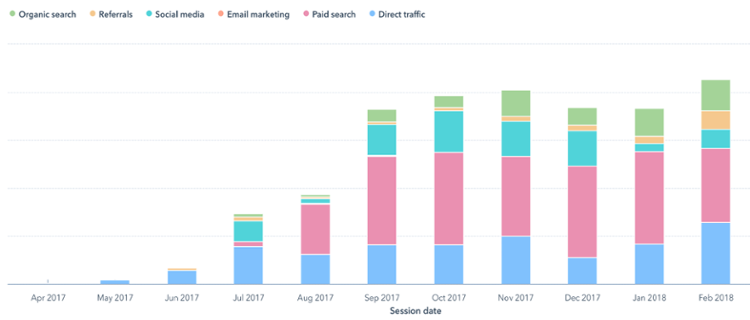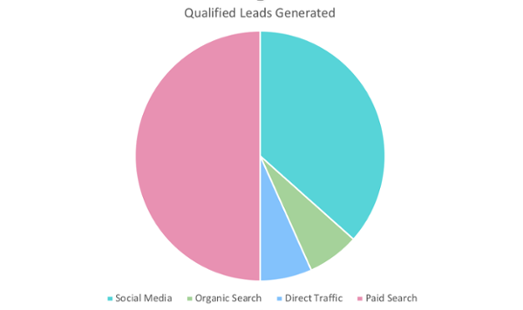Don't get weighed down by poor B2B website design and risk an even worse user experience. Verity Dearsley explains the concept of growth-driven design and how it can engage visitors, lift ROI and propel your business onwards and upwards.
While it’s a given that in this day and age a website is a necessary part of any marketing strategy, there are still many that fail to properly understand the purpose and value of having a presence online.
The majority of B2B purchase decisions start with Google and, for the most part, a website meets prospects and customers long before anyone else in a business – including the sales team.
When developing or revamping a website, instead of thinking “what do I want to say about my business”, businesses need to ask what their customers will want to know about the business and focus on the questions those customers want answers to, in relation to having their problems solved.
A good website should increase your business’s exposure on search engine results pages, but it should also help customers with these questions; it should not be a sales pitch (Learn how to build a website from scratch)
Prospects are more empowered than ever and more likely to actively search for solutions and answers on their own, rather than waiting for a cold call.
Nowadays, a website must serve as a source of information for prospects; a resource they can use to find the answers to their most significant questions, and it must provide them with other ways to engage on levels other than a ‘contact us’ button.
If a website fails to provide prospects with the information they need and a way to engage, they will go somewhere else.
Growth-driven B2B website design
Traditional website development costs a lot of money – between £11,000 and £60,000 according to Luke Summerfield of HubSpot – which is a substantial cost for a small business, especially as this needs to be paid upfront either in full or in halves.
Not to mention that it can take up to six months – or more with delays and other disruptions – to actually design and develop the site, with no results to show for it until after it eventually launches.
With the potential for high initial costs, delays causing missed deadlines and the lack of a guarantee that a new site will make any difference, it is perhaps no surprise that many businesses hesitate on the idea of investing in a website.
There’s a more cost-effective, strategic and results-orientated approach you should be using – and it’s one we use for our clients when it comes to website design and redevelopment.
The idea of Growth-Driven Design (GDD) is to reduce the overall up-front cost of a website and ensure businesses go to market quicker with a product that can be easily expanded moving forward.
And here’s how it can work for your business.
Case study: sales recruiter site
A client of ours, ecruit – a specialist, fixed-fee sales recruiter – came to us asking for assistance in planning, building and developing a website. At the time, ecruit was a brand new business venture and it needed a high-quality website as quickly as possible to start generating interest and leads to help it grow.
We started by defining a GDD website build strategy, a strategy that would allow ecruit to start with a minimum viable product (MVP) website (the most strategically effective website to launch within the shortest possible period of time) in 13 weeks, and agreed to build out the website on an ongoing basis. We identified ecruit’s most valuable pages and agreed to go live with those for phase one, adding more pages in phases two and three.
Each web page was search engine optimised for specific, long-tail keyword terms to ensure they would attract the right website visitors, and we built an additional ten pages per quarter, allowing ecruit to target additional industries and facilitate the addition of new service offerings.
Once the MVP website was live, we used HubSpot analytics to track website activity and performance, allowing us to understand what website visitors were engaging with on individual web pages and the site as a whole. We then used that information to refine the existing pages and inform our design of future ones.
We continued to build out the website in phases two and three, and supported ecruit’s website traffic through a comprehensive pay-per-click (PPC) campaign and inbound marketing (or content marketing). Here’s what happened:

The graph shows ecruit’s website traffic statistics.
We used our initial findings on the website’s performance in phase one to inform our website page creation and optimisation in phases two and three. As a result, ecruit was able to generate more organic traffic to the website over time, supported by a strong social media campaign (conducted by ourselves) and PPC activity.
The success of the programme has meant that ecruit has been able to expand its website rapidly and dive into other vertical markets in the recruitment sector.
With pages fully search engine optimised and PPC supporting lead generation activity, ecruit was able to generate a number of quality sales leads for the business in three months, seeing a great return on investment (ROI) and continues to do so.

All of this was achieved in under a year with GDD. You can watch the case study video here.
By using GDD, ecruit is now in a position where:
- Its website is constantly growing
- Interested parties can find the website online for specific search terms
- Organic traffic continues to increase
- Lead generation continues to rise and has allowed ecruit to expand into new market verticals
In less than a year, using a GDD strategy, we were able to develop a lead-generating, prospect-orientated and fantastic looking website for ecruit. Anyone arriving on the website is able to find what they are looking for with ease – the sitemap is simple and straightforward, the most important pages are featured on the main navigation, the website is clean and sleek and all the information is visible.
A good user experience is absolutely essential when it comes to modern website design. If a website is designed and has all the points mentioned in the previous paragraph, website visitors will have a pleasant experience and be more likely to come back. Check out these optimisation statistics published by HubSpot.
How much did it cost? Unlike traditional website design, with GDD you pay three months’ down payment and then an agreed monthly fee for the duration. The benefit is that you don’t break the bank trying to design a new website or redesign your existing one (something your finance team will love you for). What’s key to note is that we developed this website from scratch. We had no existing data or information – imagine if we had existing content assets.
Your website is your best asset and salesperson. It’s time to start treating it properly.
Have an opinion on this article? Please join in the discussion: the GMA is a community of data driven marketers and YOUR opinion counts.







Leave your thoughts